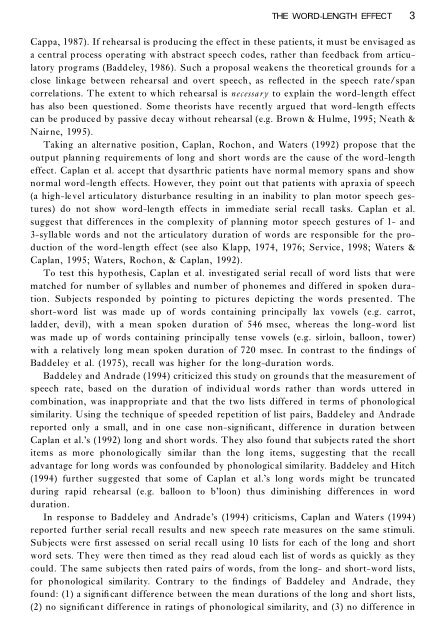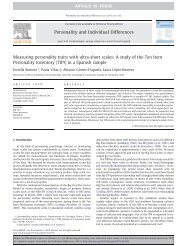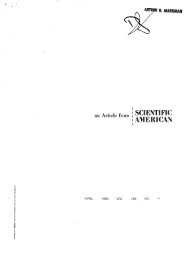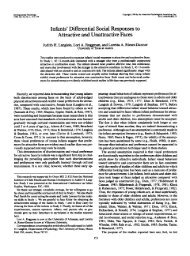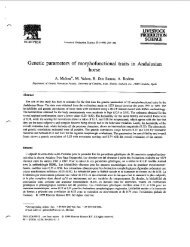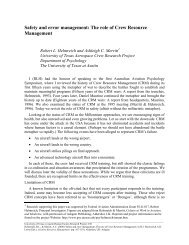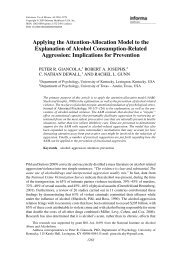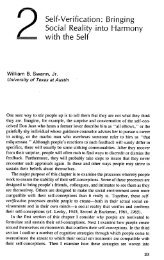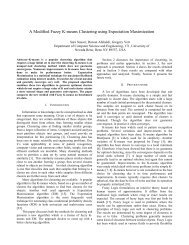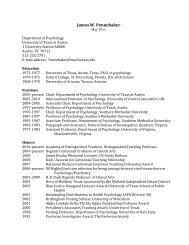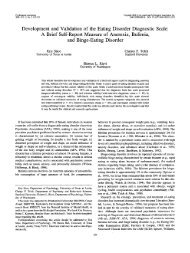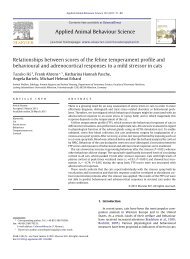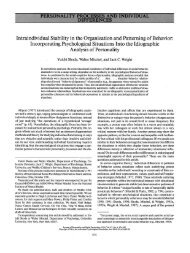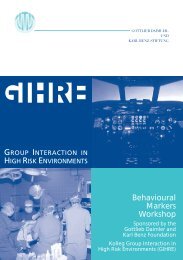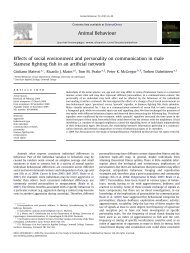The Word-Length Effect and Disyllabic Words (Lovatt
The Word-Length Effect and Disyllabic Words (Lovatt
The Word-Length Effect and Disyllabic Words (Lovatt
Create successful ePaper yourself
Turn your PDF publications into a flip-book with our unique Google optimized e-Paper software.
THE WORD-LENGTH EFFECT 3<br />
Cappa, 1987). If rehearsal is producing the effect in these patients, it must be envisaged as<br />
a central process operating with abstract speech codes, rather than feedback from articulatory<br />
programs (Baddeley, 1986). Such a proposal weakens the theoretical grounds for a<br />
close linkage between rehearsal <strong>and</strong> overt speech, as re¯ected in the speech rate/span<br />
correlations. <strong>The</strong> extent to which rehearsal is necessary to explain the word-length effect<br />
has also been questioned. Some theorists have recently argued that word-length effects<br />
can be produced by passive decay without rehearsal (e.g. Brown & Hulme, 1995; Neath &<br />
Nairne, 1995).<br />
Taking an alternative position, Caplan, Rochon, <strong>and</strong> Waters (1992) propose that the<br />
output planning requirements of long <strong>and</strong> short words are the cause of the word-length<br />
effect. Caplan et al. accept that dysarthric patients have normal memory spans <strong>and</strong> show<br />
normal word-length effects. However, they point out that patients with apraxia of speech<br />
(a high-level articulatory disturbance resulting in an inability to plan motor speech gestures)<br />
do not show word-length effects in immediate serial recall tasks. Caplan et al.<br />
suggest that differences in the complexity of planning motor speech gestures of 1- <strong>and</strong><br />
3-syllable words <strong>and</strong> not the articulatory duration of words are responsible for the production<br />
of the word-len gth effect (see also Klapp, 1974, 1976; Service, 1998; Waters &<br />
Caplan, 1995; Waters, Rochon, & Caplan, 1992).<br />
To test this hypothesis, Caplan et al. investigated serial recall of word lists that were<br />
matched for number of syllables <strong>and</strong> number of phonemes <strong>and</strong> differed in spoken duration.<br />
Subjects responded by pointing to pictures depicting the words presented. <strong>The</strong><br />
short-word list was made up of words containing principally lax vowels (e.g. carrot,<br />
ladder, devil), with a mean spoken duration of 546 msec, whereas the long-word list<br />
was made up of words containing principally tense vowels (e.g. sirloin, balloon, tower)<br />
with a relatively long mean spoken duration of 720 msec. In contrast to the ®ndings of<br />
Baddeley et al. (1975), recall was higher for the long-duration words.<br />
Baddeley <strong>and</strong> Andrade (1994) criticiz ed this study on grounds that the measurement of<br />
speech rate, based on the duration of individu al words rather than words uttered in<br />
combination, was inappropriate <strong>and</strong> that the two lists differed in terms of phonological<br />
similarity. Using the technique of speeded repetition of list pairs, Baddeley <strong>and</strong> Andrade<br />
reported only a small, <strong>and</strong> in one case non-signi®cant, difference in duration between<br />
Caplan et al.’s (1992) long <strong>and</strong> short words. <strong>The</strong>y also found that subjects rated the short<br />
items as more phonologically similar than the long items, suggesting that the recall<br />
advantage for long words was confounded by phonological similarity. Baddeley <strong>and</strong> Hitch<br />
(1994) further suggested that some of Caplan et al.’s long words might be truncated<br />
during rapid rehearsal (e.g. balloon to b’loon) thus diminishing differences in word<br />
duration.<br />
In response to Baddeley <strong>and</strong> Andrade’s (1994) criticisms, Caplan <strong>and</strong> Waters (1994)<br />
reported further serial recall results <strong>and</strong> new speech rate measures on the same stimuli.<br />
Subjects were ®rst assessed on serial recall using 10 lists for each of the long <strong>and</strong> short<br />
word sets. <strong>The</strong>y were then timed as they read aloud each list of words as quickly as they<br />
could. <strong>The</strong> same subjects then rated pairs of words, from the long- <strong>and</strong> short-word lists,<br />
for phonological similarity. Contrary to the ®ndings of Baddeley <strong>and</strong> Andrade, they<br />
found: (1) a signi® cant difference between the mean durations of the long <strong>and</strong> short lists,<br />
(2) no signi®cant difference in ratings of phonological similarity, <strong>and</strong> (3) no difference in


